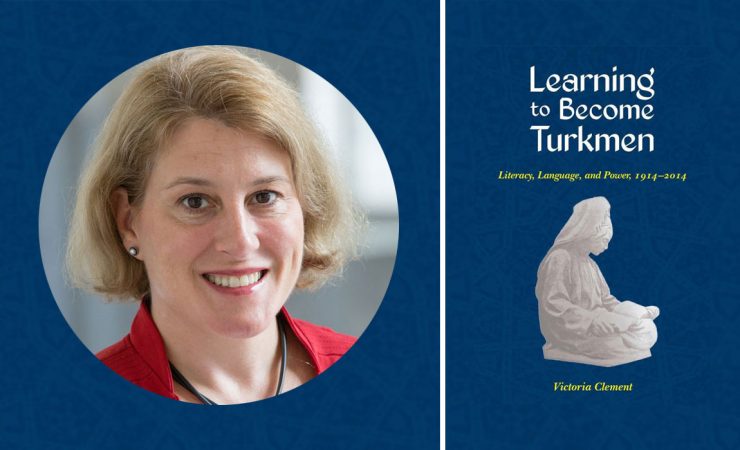Victoria Clement is a scholar, historian, and author who has traveled widely in Central Asia and has lived in Russia and Turkmenistan (2001-2003). Her book, Learning to Become Turkmen: Literacy, Language, and Power, 1914-2014, was published by the University of Pittsburgh Press in 2018. She has been a professor at the Naval Postgraduate School in Monterey, CA and a fellow at the Woodrow Wilson Center for International Scholars in Washington, DC (2016-2017). She is currently the Eurasia Regional Analyst at the Center for Advanced Operational Culture Learning at the Marine Corps University in Quantico, VA.
We talked to Ms. Clement about her book.
What do you talk about in the book?
My book, Learning to Become Turkmen, explores the history of Turkmen national identity formation over the period of a century. Questions about identity did not begin in 1914, but in that year a shift occurred with the publication of the first Turkmen-Persian language newspaper, Ruznama-i Mawera-i Bahr-i Hazar. This newspaper published articles about identity (Türkmençilik), custom (däp dessurlary), education, gender related issues (galyň, marriage) and more. Many of those same issues were raised again during the Soviet period and resurfaced yet again after independence in 1991. The people of Turkmenistan have long been concerned with their distinctiveness, how to symbolize that, and how they situate themselves in the larger world.
One way that Turkmen have symbolized their identity was through alphabet reform. For centuries, they used an Arabic script to symbolize their membership in the Muslim umma (community of believers); they began using a Latin-based script during the early Soviet years as a marker of modernity; they, like most Soviets, adopted a Cyrillic-based alphabet in 1940. Finally, with independence the leadership, with great support from local intellectuals, Turkmen designed a new Latin-based alphabet in which they wrote new histories.
The book takes a historical approach for three main reasons:
- To situate the Turkmen in greater context,
- To stress that people’s lives and local cultures traverse the boundaries of political regimes,
- To remind us that there are often historical precedents for behavior and few eras are unique.
Overall, this book aims to help readers understand how ordinary Turkmen came to feel part of a modern nation. It does not limit the discussion to the political leadership but does demonstrate the enduring connection between culture and power.
Few scholars of Central Asia focus on Turkmenistan in their research. Why did you choose it and what does researching Turkmenistan and Turkmens give you?
At first, I chose to work on the history of Turkmen because there were so few English-language materials about Turkmenistan and its people. I saw the opportunity as a creative challenge. After studying Turkmen language at Indiana University and visiting Turkmenistan, I developed a deep appreciation for Turkmen culture and values. The concept Türkmençilik (Turkmen-ness) continues to fascinate me.
Having been in the shadow of first Persian and then Russian, the Turkmen language came onto the political scene only comparatively recently. Considering that Turkmen was not the first language of most of the local Soviet elite, even though they were natives of the republic, how did the language’s newfound role affect them after independence?
The Turkmen literary language is relatively younger, but nevertheless one that is held in high esteem by its users especially in recent years. The many dialects that were spoken by the Turkmen prior to language consolidation in the 1920s were used in a society that had an oral tradition. Stories or dastans were passed down from generation to generation through the spoken word. In more recent times, we see a society with high literacy rates and numerous written histories. My book uses the finer points of this language’s development, the growth of literacy, and education reform to tell a larger story of identity and nationhood.
After independence, the language was used to bind the people together as a single nation. While there were many shared traditions and values, differences between the regions’ peoples were reflected in areas such as language (or dialects). The leadership focused on the modern literary language as a means for unifying Turkmen despite persistent peculiarities in regional speech. Today, it is one of the premier symbols for the nation.
What did you learn what you have not expected as a result of your extensive research about Turkmen identity and/or culture?
I had not expected to make so many friends during my research. I have friends in Turkmenistan who I have known for 20 and 30 years, and some more recent friendships from my latest visit in 2019. I stay in touch with them and I continue to value the relationships.
The most interesting thing I learned about Turkmen identity is the complexity of the concept Türkmençilik. It is difficult to translate into English. The closest word is Turkmen-ness. Türkmençilik embodies a combination of ancient customs, Islamic values and local customs.
Why do you want an average Turkmen speaking reader read your book? Has your work been translated into Turkmen? Does this mean anything in your work?
I hope that the average Turkmen reader finds a piece of themselves in this book. Certainly, they will see their ancestors. The history of Turkmen society is multi-layered and complex. This book attempts to excavate the layers and encourages the reader to explore them.
My work has not been translated into Turkmen prior to this effort. This has been a huge problem because I wrote the book with the Turkmen people in mind. It is only because of the assistance of a great many Turkmenistani citizens that I was able to learn the Turkmen language and conduct research. I was a guest in their country, and they were gracious hosts.


